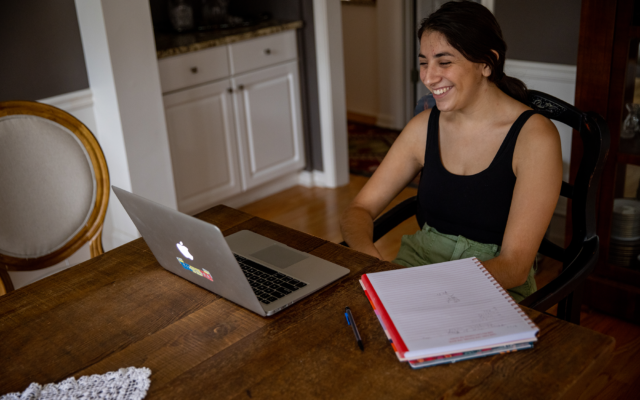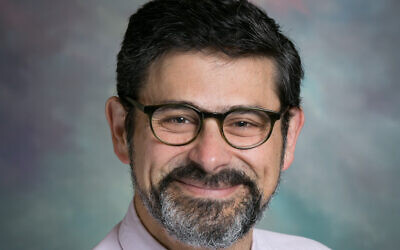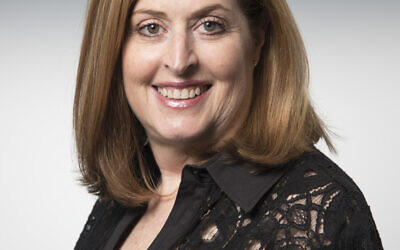Jewish Schools Learn as They Go
As schools reopened their buildings, supplies included microphones and plexiglass in larger classrooms, while hallways and stairways are one way.

For decades, the beginning of autumn meant buying new clothes for school and school supplies, from No. 2 pencils back in the 1950s and 1960s to laptop computers in this century. Everyone knew when schools would open, and everyone, perhaps particularly parents, was ready.
Welcome to the new world of living in a once-a-century killer pandemic. This year the focus was on wearing masks and staying 6 feet apart, and no one knew when or how schools would open. Indeed, “open” needed clarification; the dates the schools opened for teaching kept changing, and sometimes students were learning virtually from their homes on their laptop computers.
And, being “ready” for the onrush of students meant mornings started with temperature checks for all students and teachers, frequent handwashing during the day, cleaning and disinfecting buildings with special monitoring of ventilation systems, smaller cohorts of learning, serving lunches in classrooms instead of communal dining rooms, “mask breaks” outside and – more than anything else – a willingness and ability to be flexible.
Most of the Jewish day schools staggered their openings, starting in August, and are now fully open while allowing some virtual learning. Buses and after-school programs are still on hold in at least one school, and schools have added microphones and plexiglass dividers to many classrooms.
Atlanta’s Jewish day schools probably had an advantage over area public schools; they have smaller student populations. But that doesn’t mean it has been easy. Jewish schools often encompass a wider range of age groups. That means special accommodations need to be made for children under the age of 2, who are not required to wear masks. Teachers have had to learn how to teach in new ways, in classrooms that accommodate not only those present, but those who are learning virtually from home.
The one Jewish preschool that reported a COVID case last spring, Congregation Beth Shalom’s Alefbet Preschool, was able to reopen in June, and Risa Walter, director of Early Childhood Education, said, “Our families started returning in the summer, and our enrollment has grown this fall.”

After closing their doors suddenly last spring when the pandemic broke, the Jewish day schools had time to plan for a fall opening. David Abusch-Magder, head of school of The Epstein School, said the structures that have been put in place to deal with the COVID threat are “exhausting. Staff and teachers are exhausted. Lessons must be adjusted.” But the school year has “unfolded more or less according to plan.”
The Epstein School opened for all grades as of Oct. 5. Initially, students from early childhood to fourth grade started Aug. 10. Students from fifth to eighth grades were brought back for in-person school in smaller cohorts throughout September. “Roughly 5 to 7 percent of students, maybe 20 to 30, continued virtual learning. Students can go in and out of school on a two-week basis, unless they have to go into quarantine,” Abusch-Magder said.
Fortunately, no students or staff of The Epstein School have tested positive for COVID.
Since opening, however, the school has made adjustments. Initially students’ temperatures were taken as they disembarked from cars in the carpool line. That proved cumbersome, so the school began taking the children’s temperatures while still in their cars.
To support “exhausted” teachers, the school has engaged them in the planning. “We’re listening to their ideas and suggestions,” Abusch-Magder said. Personal protective equipment is provided to teachers as well as microphones to help them project their voices through masks and in the larger classrooms. “Plexiglass is all over the place,” he added.
Abusch-Magder credits Epstein’s emphasis on innovation, flexibility and creativity for its ability to adjust to the pandemic. “We started an innovation lab a year ago. When it came to COVID, this is not an imaginary project. This is not a fire drill. We’re doing this,” said the head of school who has a doctorate in physics and believes in science.
At The Davis Academy, in-person school began on Aug. 17 for students from Mechina, pre-K, through eighth grade. About 2 percent of students are learning from home through a “concurrent learning path,” that “allows those who are temporarily unable to be on campus due to COVID-19 concerns to participate through classroom technology and actively listen, see and participate in their classes in real-time with the other students,” said Amy Shafron, head of school.

The school has had to continue to “tweak and improve upon all that is new,” she said. “Adjustments have been made to ensure mask-wearing, distancing, regular sanitizing, daily health checks” and “arrival and dismissal procedures have been altered, cleaning procedures have been increased and enhanced, and the school has designated individualized supplies, materials and equipment for students.” School hours, at least, have not been changed.
Davis students not only receive temperature screenings when they arrive on campus but also prior to leaving for school. “Parents and staff are utilizing our new health management system called Ruvna Health” to screen and track all students, faculty and staff for COVID-19 symptoms on a daily basis. “With this system, Davis is able to create the best snapshot of the overall health picture of the greater Davis Academy family,” Shafron reported.
School opened for The Weber School students virtually on Aug. 17, with on-campus teaching and learning on Sept. 14. “Some families chose to remain virtual, so we are holding classes for students in person and have installed technology to also seamlessly include those learning from home,” said Julie Crow, director of communications and marketing,
Like the other Jewish day schools, Weber has not experienced an outbreak of COVID and is emphasizing mask-wearing, hand-washing and sanitizing of its facilities. “All learning spaces are configured so that students are seated at least 6 feet apart. We have transformed some of our larger spaces like the cafeteria, chapel and media center into large classrooms to accommodate more students socially distanced. Hallways and stairwells are one way, and we have staff overseeing all of this, as well as traffic in and out of restrooms. We also have installed large tents outside so on nice days, the students can eat outside.”
The great outdoors has become popular for a number of schools. Barrie Cohn, director of marketing and communications at the Atlanta Jewish Academy, reported, “We utilize more outdoor spaces, including our courtyard and field.”
Visitors are not allowed in the building at all, and so far, AJA’s protocols have been successful, she said. “Thankfully, not one case of COVID [has been reported] from students, faculty or staff.”
The school staggered its opening from Aug. 13 to Aug. 24, with various grades opening on four different days. But its after-school and bus programs are still on hold. “We have a Health and Safety Committee of carefully appointed experts who have been guiding us every step along the way,” Cohn said. “Our school community understands that our work together can help contain the spread, sustain our learning experience, and do our part to protect those most vulnerable to COVID-19. We want to physically be in school. Our students want to physically be in school. Our families want us to be physically in school. It’s in each of our hands to help keep that a reality.”
- Jan Jaben-Eilon
- Schools
- COVID-19
- Mask mandate
- Congregation Beth Shalom
- Risa Walter
- David Abusch-Magder
- The Epstein School
- The Davis Academy
- Amy Shafron
- Ruvna Health
- The Weber School
- social distancing
- Early Childhood Education
- COVID
- Coronavirus
- Being Jewish in the Time of Coronavirus
- Schools reopening
- Virtual school
- Jewish schools
- Education



comments